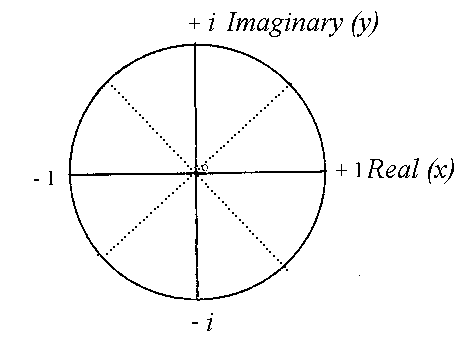In geometrical terms the diagonal co-ordinates (i.e. of the diagonal line diameters that are equidistant from horizontal and vertical axes) are as follows:

Upper-Right Quadrant k(1 + i)
Upper-Left Quadrant k(- 1 + i)
Lower-Right Quadrant k(1 - i)
Lower-Left Quadrant k(-1 - i)
In the above, k is used for convenience to represent 1/square root of 2.
In like manner in holistic mathematical terms, these co-ordinates express the "complex" nature of body-mind interactions (which simultaneously have a "real" and "imaginary" aspect).
Thus if the mental reaction is "real" (conscious) the simultaneous body reaction is "imaginary" (unconscious).
Likewise if the body reaction is "real" (conscious), the simultaneous mental reaction is "imaginary" (unconscious).In other words cognitive (mind) and affective (body) aspects are intimately connected in this manner and their corresponding integration requires balancing both successfully (represented by the equal magnitude of both aspects).
Alternatively this can be expressed as the full integration of conscious and unconscious (and unconscious and conscious).Of course with this successful reconciliation at a psychophysical level, remaining body/mind divisions cease, and spiritual emptiness (representing by the corresponding interpretation of these diagonals as null lines = 0) results.
So we here the full integration of form and emptiness (and emptiness and form).
Now in diagonal terms the Upper Right-Hand Quadrant is complementary with the Lower Left-Hand Quadrant.
Thus k(1 + i) is complementary with k(-1 - i)
Likewise the Upper Left-Hand Quadrant is complementary with the Lower Right-Hand Quadrant.
So k(- 1 + i) is complementary with k(1 - i)